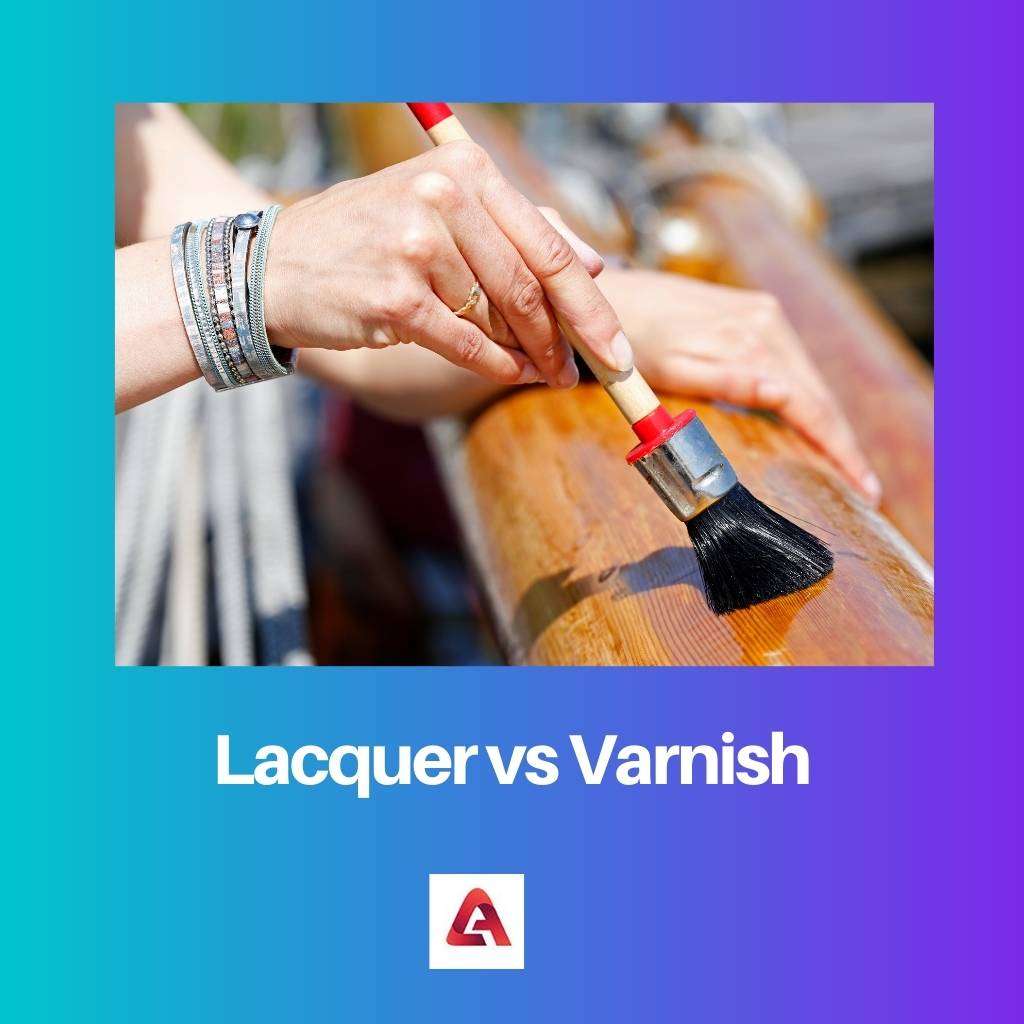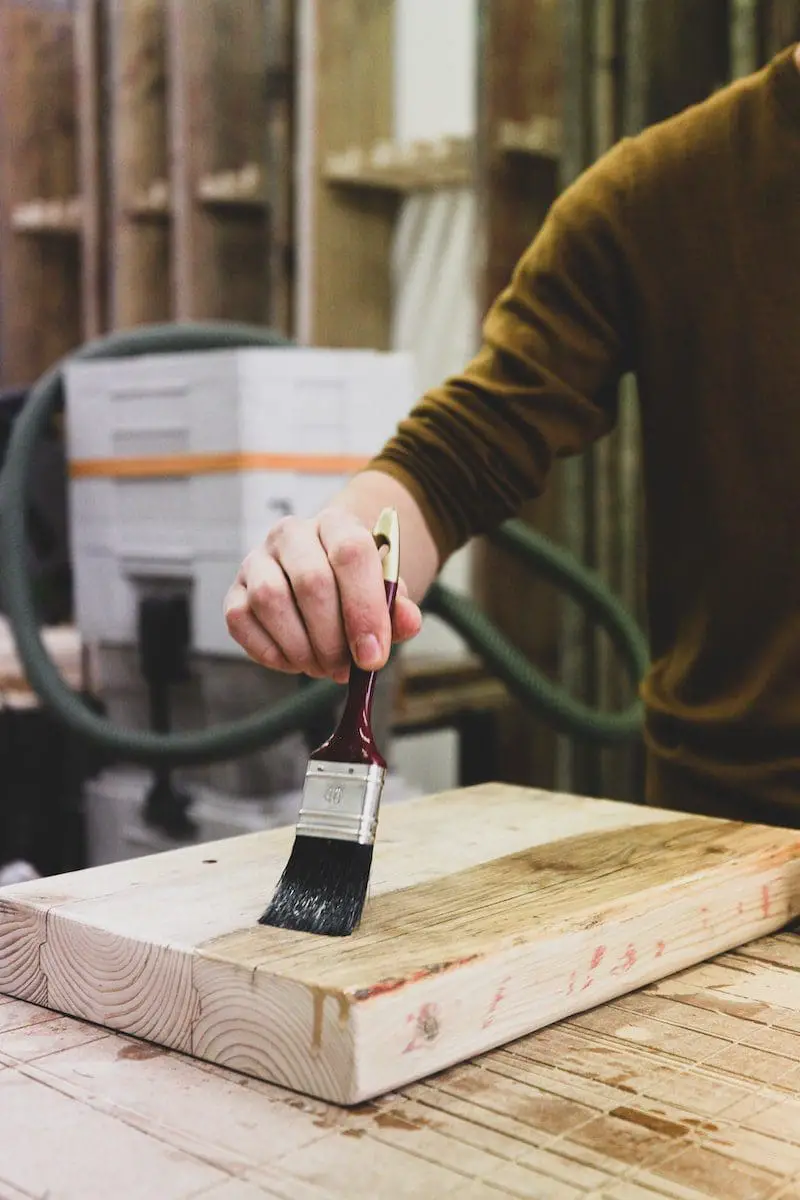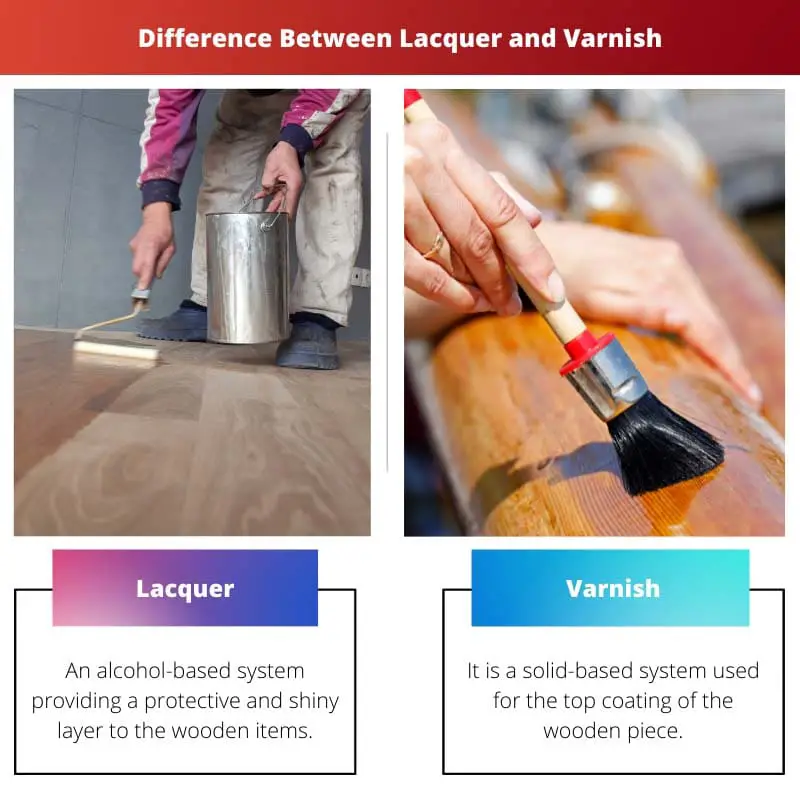People pay a lot of attention to the furniture and decorative items in their homes or their offices. Wooden furniture and pieces have been ethereal for a long time.
Even today, people prefer buying wooden items because they are beautiful, give ethereal vibes, and have a long shelf life. Lacquer and varnish are types of coating done on wooden materials for the purpose of protecting the wooden piece.
There are many types of coating available on the market for wood protection that can be used, among which lacquers and varnish are very popular due to the benefits they offer.
Key Takeaways
- Lacquer dries faster than varnish, providing a quicker finish.
- Varnish offers superior durability and protection against UV rays compared to lacquer.
- Lacquer forms a thicker, more rigid finish, while varnish creates a flexible, resilient coating.
Lacquer vs Varnish
The difference between Lacquer and Varnish is that Lacquer is a solvent-based coating, while Varnish has more solid materials in it. The former is rather a thin layer, while the latter gives a hard and tough coating to the wooden piece being coated with it. Both of them protect the wood from acid, alkali, water, and other environmental factors such as temperature, humidity, moisture, etc.

Lacquer is an alcohol-based solution having shellac present in it. The shellac is the main component responsible for the synthetic coating providing an intense gloss to the wooden piece on which the lacquer is applied.
The lacquer provides the wooden piece with a thin covering layer that gives protection against alkali, acid, water, and other factors.
Varnish is a thick solid-based system that provides a thick topcoat to the wood. It is the final coating as it provides protection against alkali, acid, water, UV radiation from sunlight, and other environmental factors.
It consists of plasticizers that are responsible for the protective action as well as its consistency.
Comparison Table
| Parameters of Comparison | Lacquer | Varnish |
|---|---|---|
| Meaning | An alcohol-based system providing a protective and shiny layer to the wooden items. | It is a solid-based system used for the top coating of the wooden piece. |
| Composition | Shellac + alcohol | Plasticizer + Resin + Drying oil + Suitable solvent |
| Consistency | Thin consistency | Thick consistency than lacquers |
| Protection | Provides protection against alkali, acid, water, and some other environmental factors but does not protect against UV radiation. | Provides protection against alkali, acid, water, UV radiation from the sunlight, and other environmental factors. |
| Function | Protection; provides intense shiny gloss. | Protection; provides sheer finish to matte finish. |
| Application | By a sprayer | Applied using a brush |
| Visual effects | Provides a thin layer of transparent coating which retains the original grain of the wood. | It is not that transparent, and the final grain can be slightly different from than original piece. |
What is Lacquer?
Lacquer is a solvent-based product used for wooden things to give them a glossy appearance. Lacquers are basically alcoholic solutions containing shellac, which provides a synthetic coating that gives the wooden piece an extra intense gloss.
The coating is thin and can discolor or get scratched as time flies.
Lacquers are solvents based and have a thin consistency, which makes the application of the lacquers easy. It can be applied with the use of a sprayer.
Also, it dries very quickly due to the thin consistency and being an alcohol-based product, as the alcohol is volatile in nature. The lacquers are resistant to acid, alkali, and water.
However, as time passes, the color can fade, and it may have scratches. This can be prevented by applying a layer of lacquer when the color starts fading or when scratches are seen.
The gloss provided by lacquer has an intensely sharp, shiny nature and makes the wood look extra polished. This kind of coating is preferred in polishing doors, decorative, and luxury items.

What is Varnish?
Varnish is a hard, transparent protective cover done on wooden objects for their protection from the external environment. It is the topcoat or the finishing coating done on the wooden objects.
The products get a glossy appearance after the varnish is applied.
The protective coat is highly durable as it contains a lot of solid materials. Varnishing is done on wood and also provides protection against UV light.
The chemical composition of varnish can be described as a mixture of resin, drying oil and a thinner mixture in a suitable solvent. This produces a clear and hard solution.
The coating provides a glossy surface but a hard cover.
The varnish protects the wooden piece from acid, alkali, UV radiation, and other factors. It protects the wood’s texture and its color from fading.
Another good property of varnish is that it’s colorless. So, it can be easily used as a topcoat or finish coat and will enhance the natural wooden grain of the product.
The number of coatings to be applied can differ based on the wooden item and the purpose of the varnish.

Main Differences Between Lacquer and Varnish
- Both varnish and lacquers provide gloss. While lacquer gives an intense gloss, the varnish provides sheen finish levels.
- Lacquers are less durable than varnish. Varnish can protect the wood against acid, alkali, UV light, and abrasions, while lacquers can protect against all the factors except for the protection against the sunlight.
- Varnished contain plasticizers, while lacquers do not.
- Varnish protects the wood against UV light, whereas lacquer does not.
- Lacquers can be applied by a sprayer, while varnish cannot be applied by a sprayer. A varnish is applied by a brush as it has a thick consistency.

- https://www.bcin.ca/bcin/detail.app?id=66297
- https://ojs.cnr.ncsu.edu/index.php/BioRes/article/view/BioRes_06_2_1648_Cakicier_KS_Varnish_Hardness_Scratch_Heat_Treat
- https://pubs.acs.org/doi/pdf/10.1021/ie50318a003
I found the information about the visual effects and the application of lacquer and varnish to be particularly enlightening.
Yes, the focus on visual effects and application was very well presented.
I couldn’t agree more. The article was very detailed in these areas.
The protective functions and the longevity of lacquer and varnish are well explained here. Great read.
I couldn’t agree more. The details provided are excellent.
The article also provides a detailed explanation of the chemical composition of both lacquer and varnish. Very informative.
Agreed. The chemical composition details were very helpful in understanding the differences.
Absolutely, it’s quite comprehensive and gives a good understanding of the topic.
The comparison of the protective capabilities of lacquer and varnish is very insightful. It’s a great article.
I found the protective comparisons to be especially helpful in understanding the differences between lacquer and varnish.
The protective details were indeed very informative.
The protective functions and the chemical composition details for both lacquer and varnish were great to read.
The chemical details and protective functions were particularly enlightening.
Agreed. It’s a very comprehensive article.
I appreciate the comparison between the application and visual effects of lacquer and varnish in the article.
Yes, the comparison of the application process and visual impact was very useful.
The details about the protective functions and application process for both lacquer and varnish were particularly insightful.
I found the protective function details to be very well explained.
Absolutely. Great information on these aspects.
The article explains the functionality of both lacquer and varnish very well.
Absolutely. The details provided are very informative.
The functionality explanations were excellent. Very detailed.
This article gives a very comprehensive examination of the differences between varnish and lacquer.
I couldn’t agree more. The visual comparison table makes it clear and easy to understand.
The article does a great job explaining the differences and benefits of both lacquer and varnish.
Yes, the comparisons were very well presented.